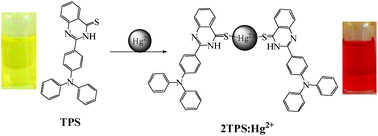A highly selective and naked-eye sensor for Hg2+ based on quinazoline-4(3H)-thione†
Abstract
A highly selective colorimetric and fluorescent sensor for Hg2+, TPS (TPS =

* Corresponding authors
a
Key Laboratory for Organic Electronics and Information Displays (KLOEID), Institute of Advanced Materials (IAM), Nanjing University of Posts and Telecommunications, Nanjing 210046, China
E-mail:
iamqbmei@njupt.edu.cn
b
College of Metallurgy and Resources, Anhui University of Technology, Ma'anshan, Anhui 243002, P. R. China
E-mail:
tongbihai@ahut.edu.cn
A highly selective colorimetric and fluorescent sensor for Hg2+, TPS (TPS =

 Please wait while we load your content...
Something went wrong. Try again?
Please wait while we load your content...
Something went wrong. Try again?
Q. Mei, L. Wang, B. Tian, F. Yan, B. Zhang, W. Huang and B. Tong, New J. Chem., 2012, 36, 1879 DOI: 10.1039/C2NJ40400A
To request permission to reproduce material from this article, please go to the Copyright Clearance Center request page.
If you are an author contributing to an RSC publication, you do not need to request permission provided correct acknowledgement is given.
If you are the author of this article, you do not need to request permission to reproduce figures and diagrams provided correct acknowledgement is given. If you want to reproduce the whole article in a third-party publication (excluding your thesis/dissertation for which permission is not required) please go to the Copyright Clearance Center request page.
Read more about how to correctly acknowledge RSC content.
 Fetching data from CrossRef.
Fetching data from CrossRef.
This may take some time to load.
Loading related content
